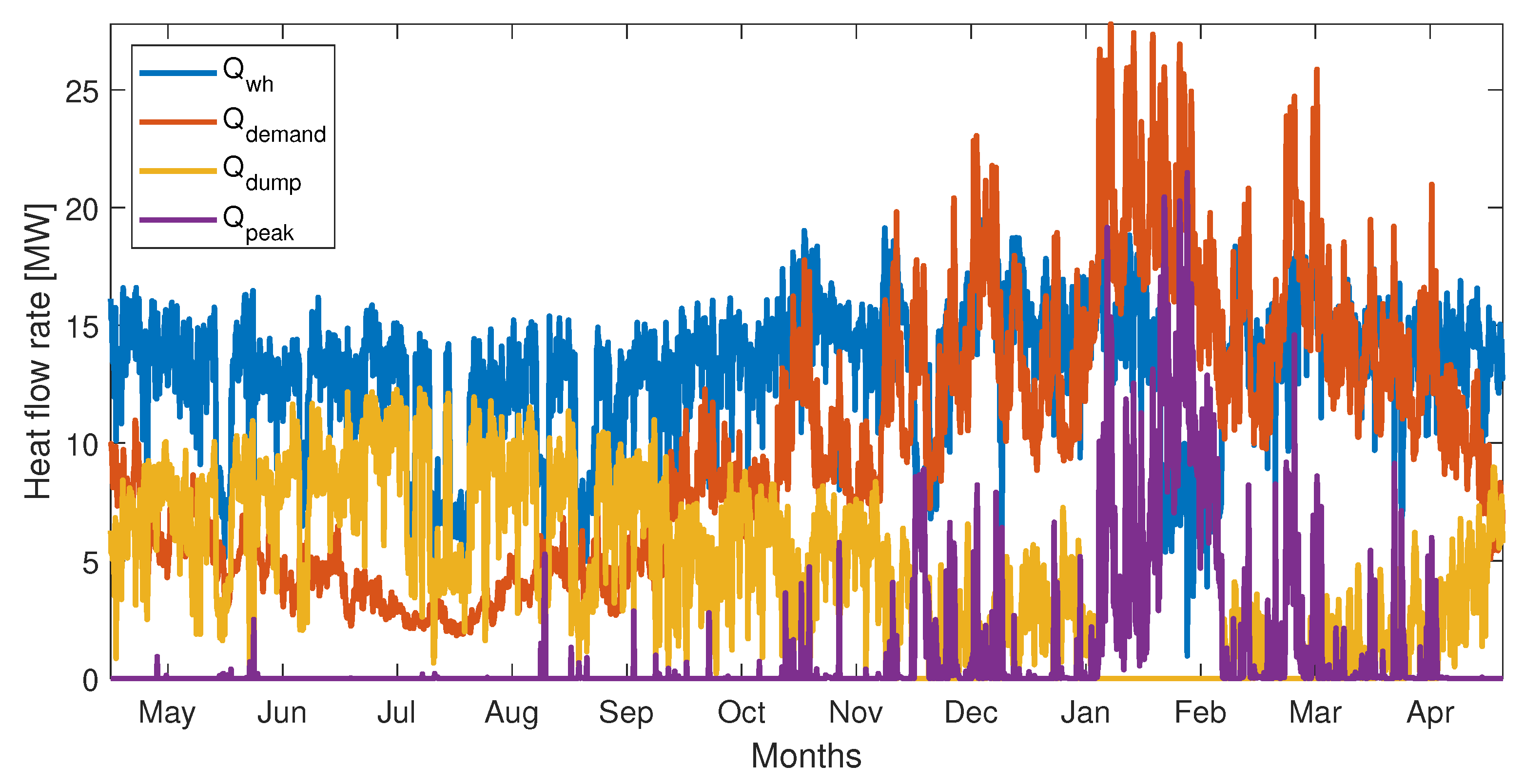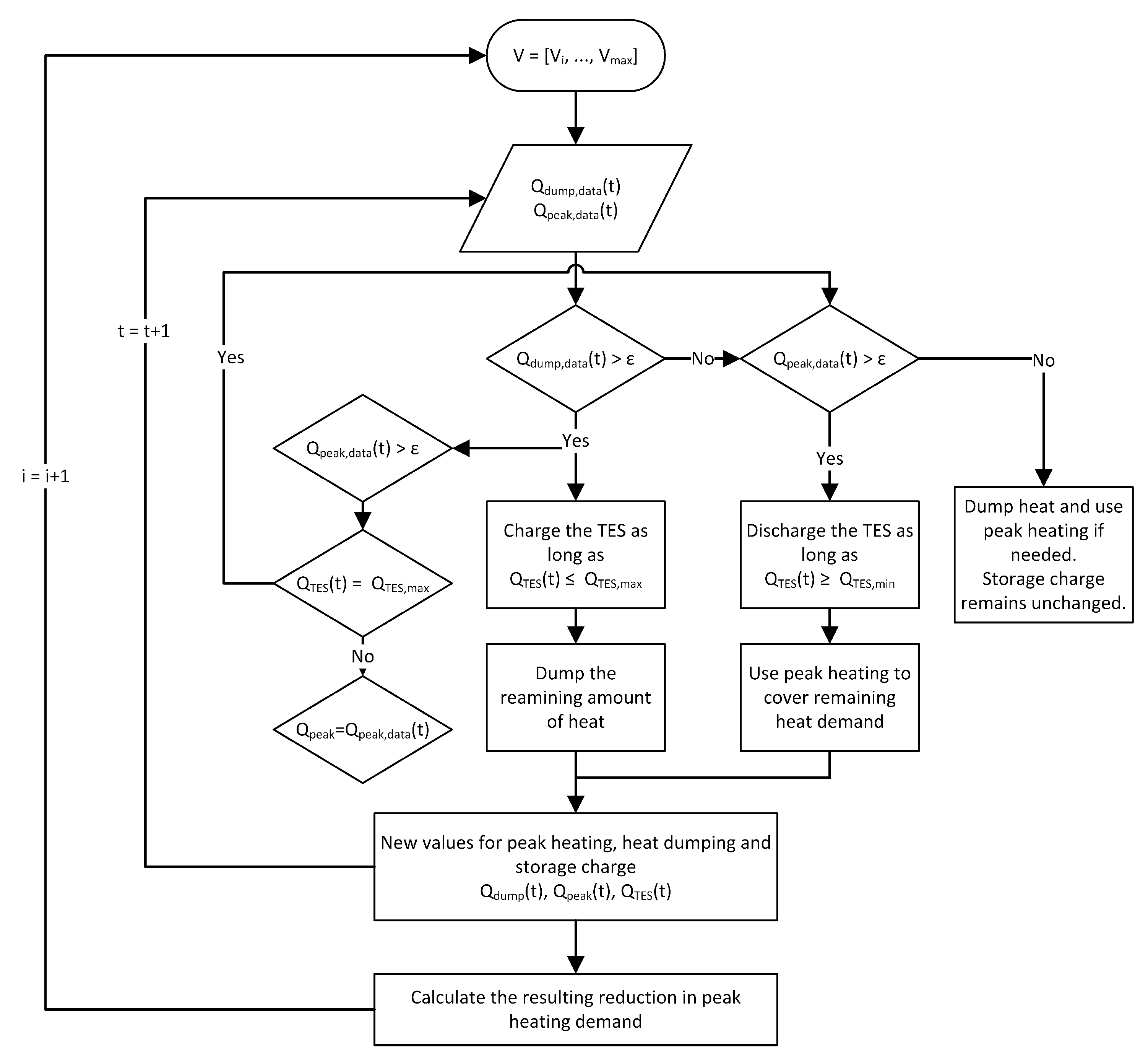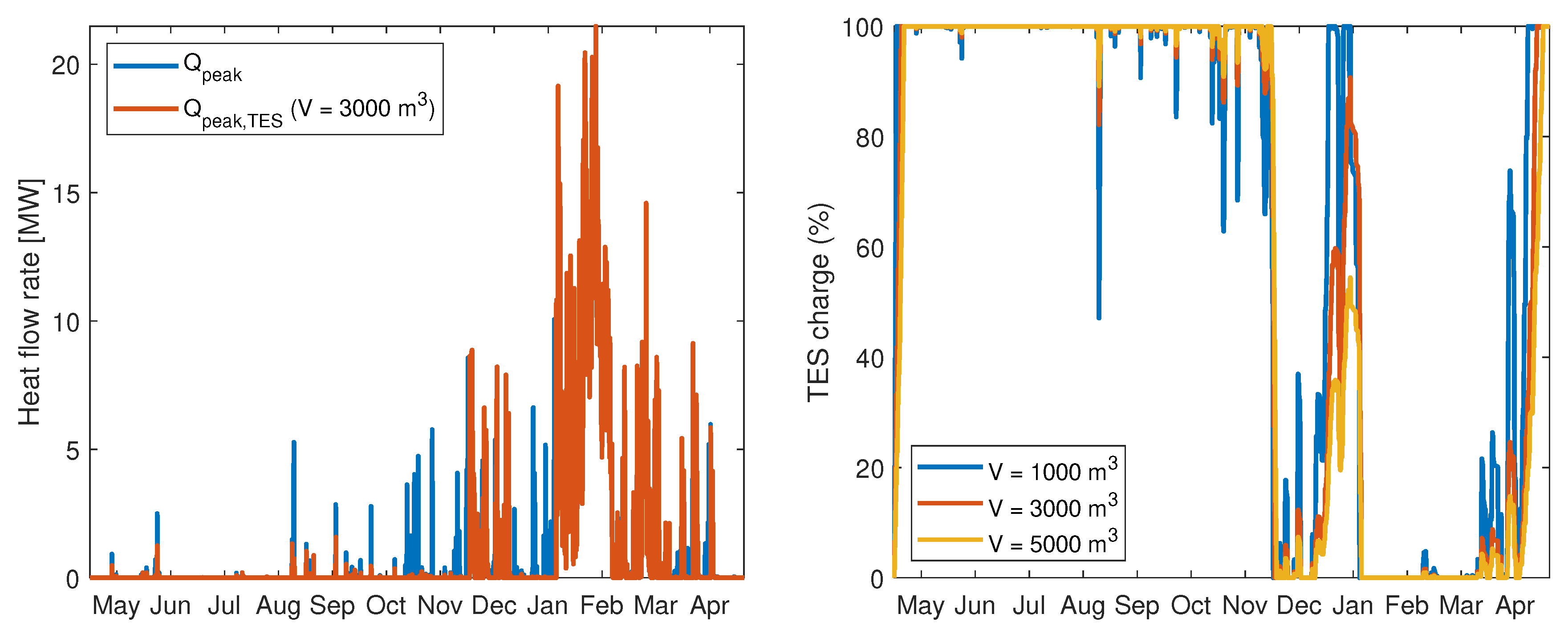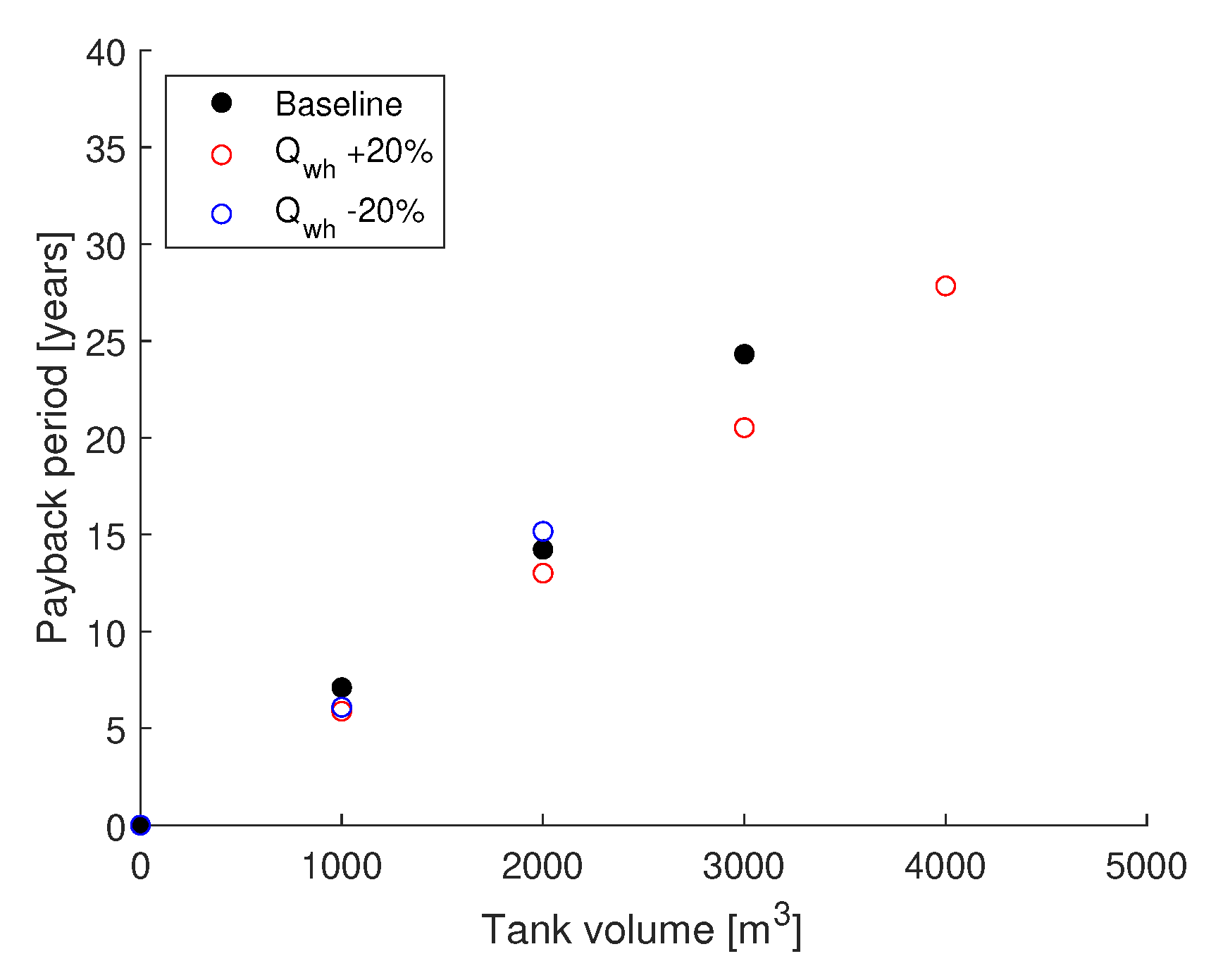Potential of Thermal Energy Storage for a District Heating System Utilizing Industrial Waste Heat
Abstract
:1. Introduction
2. Materials and Methods
2.1. Case Study Description
- CO gas available: CO (boiler 2) as the primary and electricity (boiler 4) as the secondary peak heating source.
- CO gas not available: Electricity (boiler 4) as the primary and oil (boiler 1) as the secondary peak heating source.
2.2. Calculating the Reduction in Peak Heating as a Function of Tank Size
2.3. Economic Evaluation
Emissions
3. Results and Discussion
3.1. Reduction in Peak Heating
3.2. Reduction in Emissions
3.3. Economic Evaluation
3.4. Sensitivity Analysis
- CO emission factor: 0/0.574 kg/kWh, where 0.574 kg/kWh is considered as the baseline
- CO tax: ±50% variation from the baseline of 250 NOK/ton
- Electricity prices: ±43% variation
- Interest rate: varied from 4 to 12% with 8% as the baseline
- Waste heat: ±20% variation in the amount of available waste heat
4. Conclusions
Author Contributions
Funding
Acknowledgments
Conflicts of Interest
References
- Persson, U.; Möller, B.; Werner, S. Heat Roadmap Europe: Identifying strategic heat synergy regions. Energy Policy 2014, 74, 663–681. [Google Scholar] [CrossRef]
- Miró, L.; Gasia, J.; Cabeza, L.F. Thermal energy storage (TES) for industrial waste heat (IWH) recovery: A review. Appl. Energy 2016, 179, 284–301. [Google Scholar] [CrossRef] [Green Version]
- Guelpa, E.; Verda, V. Thermal energy storage in district heating and cooling systems: A review. Appl. Energy 2019, 252, 113474. [Google Scholar] [CrossRef]
- Hennessy, J.; Li, H.; Wallin, F.; Thorin, E. Flexibility in thermal grids: A review of short-term storage in district heating distribution networks. Energy Procedia 2019, 158, 2430–2434. [Google Scholar] [CrossRef]
- Münster, M.; Morthorst, P.E.; Larsen, H.V.; Bregnbæk, L.; Werling, J.; Lindboe, H.H.; Ravn, H. The role of district heating in the future Danish energy system. Energy 2012, 48, 47–55. [Google Scholar] [CrossRef] [Green Version]
- Trømborg, E.; Bolkesjø, T.F.; Havskjold, M.; Kirkerud, J.G.; Sandberg, E.; Kipping, A.; Tveten, Å.G. Improved Energy System through Smart Interactions between Electrical Power and Thermal Energy; Final Report from the Flexelterm Research Project. Technical Report; Norwegian University of Life Sciences: Ås, Norway, 2017. [Google Scholar]
- Wang, K.; Satyro, M.A.; Taylor, R.; Hopke, P.K. Thermal energy storage tank sizing for biomass boiler heating systems using process dynamic simulation. Energy Build. 2018, 175, 199–207. [Google Scholar] [CrossRef]
- Cole, W.J.; Powell, K.M.; Edgar, T.F. Optimization and advanced control of thermal energy storage systems. Rev. Chem. Eng. 2012, 28, 81–99. [Google Scholar] [CrossRef]
- Andersson, S.; Dimle, P.; Eriksson, A.; Aabyhammar, T. Seasonal Storage of Heat from Coal or Waste Heat in District Heating Systems. Cost Analysis and Assessment of Potential; Technical Report; Statens Raad foer Byggnadsforskning: Stockholm, Sweden, 1985. [Google Scholar]
- Köfinger, M.; Schmidt, R.; Basciotti, D.; Terreros, O.; Baldvinsson, I.; Mayrhofer, J.; Moser, S.; Tichler, R.; Pauli, H. Simulation based evaluation of large scale waste heat utilization in urban district heating networks: Optimized integration and operation of a seasonal storage. Energy 2018, 159, 1161–1174. [Google Scholar] [CrossRef]
- Nordell, B.; Andersson, O.; Rydell, L.; Scorpo, A.L. Long-term performance of the HT-BTES in Emmaboda, Sweden. In Proceedings of the Greenstock 2015: International Conference on Underground Thermal Energy Storage, Beijing, China, 19–21 May 2015. [Google Scholar]
- Cao, J. Optimization of thermal storage based on load graph of thermal energy system. Int. J. App. Thermodyn. 2000, 3, 91–97. [Google Scholar]
- Pinnau, S.; Breitkopf, C. Determination of Thermal Energy Storage (TES) characteristics by Fourier analysis of heat load profiles. Energy Convers. Manag. 2015, 101, 343–351. [Google Scholar] [CrossRef]
- Labidi, M.; Eynard, J.; Faugeroux, O. Optimal design of thermal storage tanks for multi-energy district boilers. In Proceedings of the 4th Inverse Problems, Design and Optimization Symposium (IPDO-2013), Albi, France, 26–28 June 2013. [Google Scholar]
- Nakkila Works Oy. Available online: https://nakkilaworks.fi/ota-yhteytta/ (accessed on 26 June 2020).
- Tveiten, J. Klimaregnskap for Fjernvarme; Norsk Fjernvarme: Oslo, Norway, 2014. [Google Scholar]
- Sidelnikova, M.; Weir, D.E.; Groth, L.H.; Nybakke, K.; Stensby, K.E.; Langseth, B.; Fonneløp, J.E.; Isachsen, O.; Haukeli, I.; Paulen, S.L.; et al. Kostnader i Energisektoren; Norges Vassdrags- og Energidirektorat (NVE): Oslo, Norway, 2015. [Google Scholar]
- Rathgeber, C.; Hiebler, S.; Lävemann, E.; Dolado, P.; Lazaro, A.; Gasia, J.; De Gracia, A.; Miró, L.; Cabeza, L.F.; König-Haagen, A.; et al. IEA SHC Task 42/ECES Annex 29—A Simple Tool for the Economic Evaluation of Thermal Energy Storages. Energy Procedia 2016, 91, 197–206. [Google Scholar] [CrossRef] [Green Version]









| Boiler | Energy Source | Capacity | Priority | |
|---|---|---|---|---|
| Scenario 1 | Scenario 2 | |||
| 1 | Oil | 10 MW | NA | 3 |
| 2 | CO | 10 MW | 2 | NA |
| 3 | Oil | 10 MW | NA | NA |
| 4 | Electricity | 13 MW | 3 | 2 |
| 5 | Off-gas | 8 MW | 1 | 1 |
| 6 | Off-gas | 8 MW | 1 | 1 |
| CO Emissions [kg/kWh] | NO Emissions [kg/kWh] | |
|---|---|---|
| CO | 0/0.574 | 0.55 |
| Electricity | 0 | 0 |
| Oil | 0.289 | 0.211 |
| Scenario 1 | Scenario 2 | |||||||||
|---|---|---|---|---|---|---|---|---|---|---|
| Volume (m) | 1000 | 2000 | 3000 | 4000 | 5000 | 1000 | 2000 | 3000 | 4000 | 5000 |
| Payback period (years) | 7.1 | 14.2 | 24.3 | – | – | 16.2 | – | – | – | – |
| Reduction in total costs (%) | 14.6 | 18.5 | 20.2 | 21.7 | 23.0 | 10.0 | 13.7 | 10.0 | 11.8 | 13.6 |
| Reduction in CO emissions (%) | 19.4 | 22.1 | 23.9 | 25.6 | 27.9 | 14.8 | 16.3 | 18.5 | 19.8 | 19.8 |
| Reduction in NO emissions (%) | 18.4 | 21.0 | 22.9 | 24.6 | 26.9 | 14.8 | 16.3 | 18.5 | 19.8 | 19.8 |
© 2020 by the authors. Licensee MDPI, Basel, Switzerland. This article is an open access article distributed under the terms and conditions of the Creative Commons Attribution (CC BY) license (http://creativecommons.org/licenses/by/4.0/).
Share and Cite
Kauko, H.; Rohde, D.; Knudsen, B.R.; Sund-Olsen, T. Potential of Thermal Energy Storage for a District Heating System Utilizing Industrial Waste Heat. Energies 2020, 13, 3923. https://doi.org/10.3390/en13153923
Kauko H, Rohde D, Knudsen BR, Sund-Olsen T. Potential of Thermal Energy Storage for a District Heating System Utilizing Industrial Waste Heat. Energies. 2020; 13(15):3923. https://doi.org/10.3390/en13153923
Chicago/Turabian StyleKauko, Hanne, Daniel Rohde, Brage Rugstad Knudsen, and Terje Sund-Olsen. 2020. "Potential of Thermal Energy Storage for a District Heating System Utilizing Industrial Waste Heat" Energies 13, no. 15: 3923. https://doi.org/10.3390/en13153923





